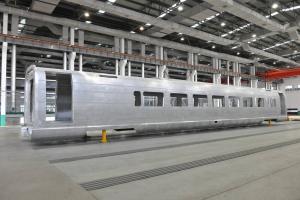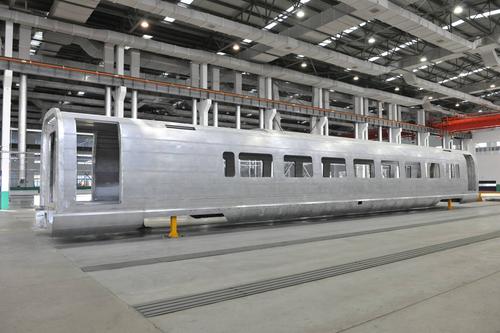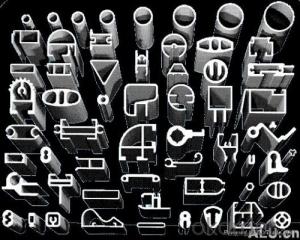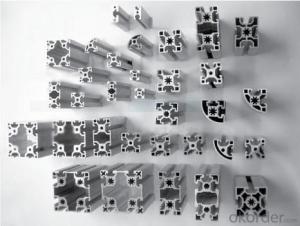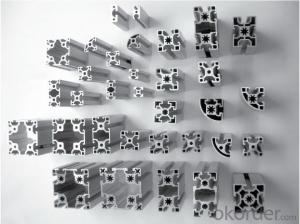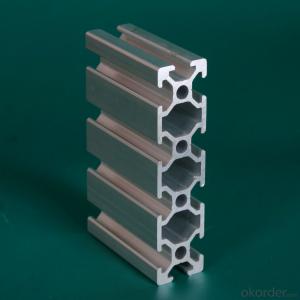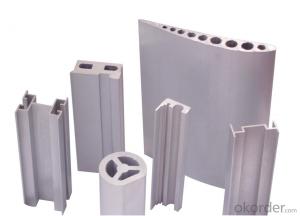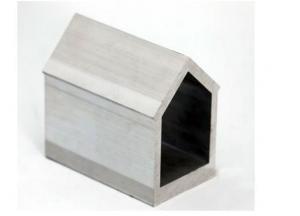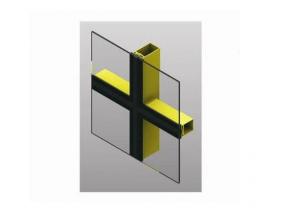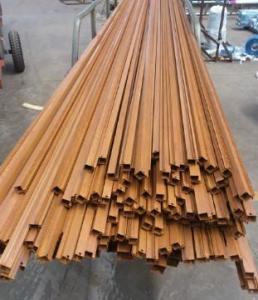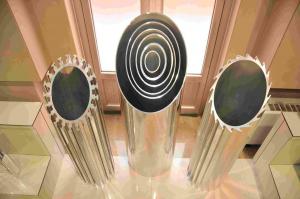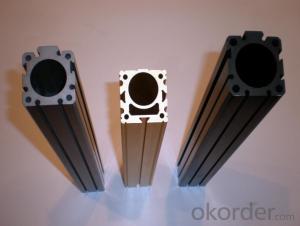Mk Aluminum Profiles for High-Speed Railway Aluminium Carriage Body Extrusion Profile
- Loading Port:
- China Main Port
- Payment Terms:
- TT OR LC
- Min Order Qty:
- -
- Supply Capability:
- -
OKorder Service Pledge
Quality Product, Order Online Tracking, Timely Delivery
OKorder Financial Service
Credit Rating, Credit Services, Credit Purchasing
You Might Also Like
Aluminium carriage body of High-speed railway made of extrusion profile .
1. Usage:High-speed railway and Metro
2. Surface: Mill finish or anodized as customer’s requirement
3. Alloy: alloy temper 6005A, 6101, 6061,etc.
4. Standard: EN755
5. Lead time: shortest delivery time
6. OEM/ODM is available
7. Advantage:
Tolerance applied by international standard
Low energy consumption, low gas emission,
high speed, environmental friendliness
- Q: What are the different surface treatments for aluminum profiles?
- Some of the different surface treatments for aluminum profiles include anodizing, powder coating, painting, and polishing.
- Q: Dongguan industrial aluminum profile manufacturers which good?
- Aluminum profile manufacturers how to choose, this problem for the just contact with aluminum profile friends, is really a need to seriously consider the problem.That choice to the aluminum factory is not good, money, goods is not good, he can give you redo is OK, but also take time; meet some black aluminum factory, and you may be wrangling, that egg pain.
- Q: how to determine its value? After these scrap to foundry on the 30...Emergency: the scrap aluminum production enterprises how to conduct accounting treatment, how to determine its value? After the aluminum foundry to exchange into ingots, to pay the processing fee to enter
- The cost of scrap is usually included in the cost of the product. Therefore, the sale of scrap, only income, there is no cost. If the need for management, the establishment of "raw materials - Waste - XXX" can also be. Examples are as follows:1, March 5th workshop in accordance with product production needs. Lead aluminum 1000kg, the unit price is 23.4567 yuanBorrow: production cost - direct material 23456.70Credit: raw materials, -XX profiles, 1000kg 23456.702 and March 25th, the waste generated by the workshop 20kg into the waste warehouse, according to the market price of 5 yuan /kg valuation, according to retire the library for accounting treatmentBorrowing: production costs - direct material -100Credit: raw materials - Scrap - profiles -20kg, -1003 and March 27th, the stock 1200kg scrap sent to the foundry for aluminum ingot, ingot factory price 6 yuan /kgBy: accounts receivable - foundries 7200Credit: other business income + tax 72004, March 27th, scrap exchange aluminum ingot 1050kg, unit price 8 yuan /kg, separately pay processing fee 1200 yuanBorrow: raw material - aluminium ingot 10508400Credit: accounts receivable - foundries 7200Accounts payable - foundries 1200Payment of processing fees (differentials)By: accounts payable 1200Cash: 1200
- Q: Can aluminum profiles be bent or shaped?
- Yes, aluminum profiles can be bent or shaped. Aluminum is a highly versatile and malleable metal that can be easily formed into various shapes and configurations. The process of bending or shaping aluminum profiles involves applying heat and force to the metal, which allows it to be manipulated into the desired form. This flexibility makes aluminum profiles an ideal choice for a wide range of applications, such as construction, automotive, and aerospace industries, where lightweight and durable materials are required. Additionally, aluminum profiles can also be extruded, which involves pushing the metal through a die to create a specific shape or cross-section. Overall, the ability to bend and shape aluminum profiles makes them a popular choice for many industries.
- Q: Is it feasible to recycle aluminum profiles economically and in significant quantities?
- <p>Yes, aluminum profiles can be recycled at a reasonable cost and volume. Recycling aluminum is more cost-effective than mining and refining new aluminum from bauxite. The process requires less energy, which reduces costs. Additionally, aluminum has a high recycling rate, with about 75% of all aluminum ever produced still in use today. This indicates that aluminum recycling is both economically viable and can be done in significant volumes, contributing to sustainability and waste reduction.</p>
- Q: How do aluminum profiles perform in terms of thermal conductivity?
- The excellent thermal conductivity of aluminum profiles is well-known. It pertains to a material's capacity to transmit heat. Aluminum possesses a notable value of thermal conductivity, enabling efficient heat transfer from one point to another. This characteristic renders aluminum profiles extremely appropriate for applications necessitating heat dissipation or transfer, such as in the fabrication of heat sinks, radiators, or electrical components. Moreover, the high thermal conductivity of aluminum profiles facilitates quicker and more effective cooling, thus making them ideal for thermal management applications.
- Q: What are the different packaging options available for aluminum profiles?
- Aluminum profiles can be packaged in various ways to meet the specific needs and preferences of manufacturers or customers. The available packaging options include bundling, boxing, tubing, palletizing, and customized solutions. For larger profiles or bulk shipments, bundling is commonly used. This involves stacking multiple profiles together and securing them with strapping or shrink wrap. Smaller profiles can be packaged in boxes, which provide protection during transportation and storage. Individual compartments within the box prevent damage from rubbing. Circular profiles can be packaged in tubes made of durable materials like cardboard or plastic. These tubes offer excellent protection from scratches or dents. When shipping in large quantities, pallets can be used. Profiles are stacked on a pallet and secured with stretch wrap or straps. This option enables easy handling and transportation using forklifts or pallet jacks. In certain cases, customized packaging may be necessary. This can include foam inserts, protective film, or other specialized materials to ensure maximum protection during transit. When selecting the appropriate packaging option for aluminum profiles, it is important to consider factors such as size, weight, fragility, and transportation requirements. Compliance with industry standards and regulations should also be taken into account to ensure safe delivery to end-users.
- Q: This question asks for a list of various aluminum profiles that are utilized in the construction of building facades and cladding systems.
- <p>Aluminum profiles for facades and cladding systems come in various types, each serving specific purposes in construction. Common types include: 1. <strong>Aluminum Extrusions</strong>: Used for structural support and can be customized for specific design requirements. 2. <strong>Aluminum Channels</strong>: Often used for attaching panels or as a part of the support structure. 3. <strong>Aluminum Angles</strong>: Provide corner support and reinforcement. 4. <strong>Aluminum Flat Bars</strong>: Used for horizontal or vertical support in facade systems. 5. <strong>Aluminum Tubes</strong>: Can be used as a decorative element or for structural reinforcement. 6. <strong>Aluminum Louvers</strong>: Designed for sun shading and ventilation. 7. <strong>Aluminum Panels</strong>: Can be flat or profiled, used for the outer layer of the facade. 8. <strong>Aluminum Trims and Mouldings</strong>: Used for finishing and detailing around windows, doors, and edges. Each type is chosen based on the architectural design, structural requirements, and aesthetic preferences.</p>
- Q: This question asks for methods to guarantee the reliability of aluminum profiles used in a construction project.
- <p>To ensure the quality of aluminum profiles in your building project, first, source from reputable suppliers with a proven track record. Request for certifications such as ISO 9001 for quality management systems. Inspect the profiles for uniformity in thickness and straightness. Check for surface defects like scratches or dents. Ensure the profiles meet the required strength and durability standards by requesting test reports or conducting your own tests. Verify the alloy composition to ensure it's suitable for your project's environmental conditions. Lastly, consider the manufacturer's warranty and after-sales service as an indicator of their confidence in product quality.</p>
- Q: Can aluminum profiles be used in noise insulation applications?
- Yes, aluminum profiles can be used in noise insulation applications. Aluminum profiles are versatile and can be designed to have excellent acoustic properties. They can be used to create soundproof windows, doors, walls, and enclosures. Aluminum profiles can be combined with materials like acoustic glass, rubber seals, and insulation foam to enhance their noise insulation capabilities. Additionally, aluminum's inherent strength and durability make it suitable for use in noise insulation applications as it can withstand the pressure and vibrations caused by sound waves. Overall, aluminum profiles offer a viable solution for noise insulation requirements in various settings, including residential, commercial, and industrial buildings.
Send your message to us
Mk Aluminum Profiles for High-Speed Railway Aluminium Carriage Body Extrusion Profile
- Loading Port:
- China Main Port
- Payment Terms:
- TT OR LC
- Min Order Qty:
- -
- Supply Capability:
- -
OKorder Service Pledge
Quality Product, Order Online Tracking, Timely Delivery
OKorder Financial Service
Credit Rating, Credit Services, Credit Purchasing
Similar products
Hot products
Hot Searches
Related keywords
